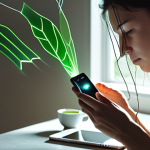Ever find yourself scrolling endlessly, feeling strangely drained yet unable to look away? It’s a common modern predicament, isn’t it? Our lives are increasingly intertwined with screens, from work to leisure, and while technology offers incredible convenience, I’ve personally noticed it often comes at the cost of our peace of mind and genuine connection.
This isn’t about shunning technology entirely; it’s about creating intentional space. It’s about a ‘digital detox’ – not just unplugging, but mindfully re-engaging with the real world around us.
In an era where AI-driven content and immersive virtual realities are becoming more prevalent, the need to reclaim our mental bandwidth and focus has never been more critical.
I’ve felt the profound difference it makes, and truly believe it’s one of the most impactful steps we can take to elevate our everyday lives. Let’s dive deeper into it below.
Ever find yourself scrolling endlessly, feeling strangely drained yet unable to look away? It’s a common modern predicament, isn’t it? Our lives are increasingly intertwined with screens, from work to leisure, and while technology offers incredible convenience, I’ve personally noticed it often comes at the cost of our peace of mind and genuine connection.
This isn’t about shunning technology entirely; it’s about creating intentional space. It’s about a ‘digital detox’ – not just unplugging, but mindfully re-engaging with the real world around us.
In an era where AI-driven content and immersive virtual realities are becoming more prevalent, the need to reclaim our mental bandwidth and focus has never been more critical.
I’ve felt the profound difference it makes, and truly believe it’s one of the most impactful steps we can take to elevate our everyday lives. Let’s dive deeper into it below.
The Unseen Weight of Constant Connectivity

There’s a subtle but significant burden that comes with being perpetually online, and I can tell you from personal experience, it’s heavier than you’d imagine. For years, I found myself tethered to my phone, checking emails at all hours, refreshing social feeds compulsively, and generally feeling like I was always “on.” It wasn’t just the late nights or the eye strain; it was the persistent underlying hum of anxiety, the feeling that I was missing something important if I wasn’t connected, and a growing sense of superficiality in my interactions. This constant state of alert, often referred to as “continuous partial attention,” fragments our focus and diminishes our capacity for deep thought and genuine presence. I remember a specific moment, sitting with friends, and realizing half of us were subtly glancing at our phones, pulling us out of the present conversation. It was a wake-up call that this digital tether was costing us more than just minutes; it was costing us moments.
1. Draining Our Mental Reserves and Attention Spans
The human brain isn’t designed for the relentless, hyper-stimulating environment of the digital world. Notifications, endless feeds, and the sheer volume of information create a constant demand on our attention, leading to what experts call “attention fatigue.” I used to pride myself on my ability to multitask, juggling multiple tabs, emails, and conversations simultaneously. But what I observed was a significant decline in my ability to concentrate on a single task for an extended period. Reading a book became a challenge, and deep work felt almost impossible. My mind would wander, seeking the next dopamine hit from a notification. It’s a real phenomenon, this shrinking of our attention spans, and it profoundly impacts our productivity, creativity, and overall mental clarity. We’re training our brains to be easily distracted, which makes it harder to truly engage with anything meaningful in the real world.
2. Eroding Our Connection to the Present Moment
One of the most insidious effects of constant digital engagement is its ability to pull us out of the present. How many times have you been somewhere beautiful, or with loved ones, only to be half-present because you’re documenting it, sharing it, or checking what others are doing? I’ve been guilty of it myself. I remember hiking in a stunning national park, phone in hand, trying to capture the perfect shot, only to realize I hadn’t actually *felt* the crisp air, or *heard* the birdsong, or *smelled* the pine trees. I was experiencing it through a screen, for an audience, rather than for myself. This habit of “living for the feed” disconnects us from our immediate surroundings, from the nuances of face-to-face interactions, and from the quiet, internal reflections that are essential for well-being. It turns life into a performance rather than an experience.
Reclaiming Serenity: The Power of Unplugging
Embracing a digital detox, even a partial one, isn’t about deprivation; it’s about reclaiming a sense of calm and clarity that often gets lost in the digital noise. When I first attempted a weekend without my phone, I felt an almost physical sense of withdrawal, a phantom vibration in my pocket. But as the hours passed, a profound stillness began to settle over me. The incessant hum of anxiety started to recede, replaced by a quiet spaciousness in my mind. It was during these moments that I truly began to understand the transformative power of silence and uninterrupted thought. It allowed me to reconnect with my inner self, to hear my own thoughts without immediate external input, and to simply exist without the pressure to consume or create. It’s a feeling of mental decompression that’s incredibly therapeutic and vital in our fast-paced world.
1. Boosting Cognitive Function and Creativity
Stepping away from screens gives your brain the much-needed space to breathe, process, and consolidate information. When you’re constantly bombarded with new inputs, your brain is in a reactive state. It’s like having twenty browser tabs open at once; nothing truly gets done efficiently. I found that during periods of digital disconnection, my ability to think creatively soared. Ideas that had been lurking in the back of my mind suddenly bubbled to the surface. Solutions to problems that felt intractable when I was glued to my laptop emerged almost effortlessly during a walk in the park. This isn’t just anecdotal; research supports that allowing your mind to wander, free from digital distractions, is crucial for divergent thinking and innovative problem-solving. It’s in these moments of ‘boredom’ or quiet reflection that true inspiration often strikes, as your brain makes new connections and integrates information without interruption.
2. Deepening Real-World Relationships and Empathy
One of the most heartening outcomes of my digital detox experiences has been the noticeable improvement in my relationships. When you’re truly present with someone, looking them in the eye, listening actively without the urge to check your phone, the quality of that interaction elevates dramatically. I’ve found conversations become richer, more meaningful, and genuinely connection-building. My friends and family have also commented on how much more engaged I seem. There’s a tangible difference when you’re not splitting your attention between a person and a glowing screen. This presence fosters greater empathy, as you’re better able to pick up on non-verbal cues and truly understand what someone is conveying. It allows for deeper bonds and a sense of belonging that no online interaction, however frequent, can ever replicate. It’s about remembering that the most important connections are always human-to-human, not screen-to-screen.
Cultivating Intentional Habits for Digital Wellness
The beauty of a digital detox isn’t about a one-off event; it’s about weaving intentional, mindful habits into the fabric of your daily life. I used to think I needed to go on a grand retreat to disconnect, but I’ve learned that small, consistent actions yield profound results. It’s about creating boundaries, not just for others, but for yourself. For me, this started with defining “no-phone zones” in my home – the dinner table, the bedroom – and setting specific times for checking emails and social media, rather than letting them dictate my day. It’s a continuous process of trial and error, figuring out what works best for your unique lifestyle, but the underlying principle is always the same: you are in control of your technology, not the other way around. This shift in mindset, from reactive to proactive, is where the true liberation lies. It’s about designing a life where technology serves you, rather than you serving it.
1. Strategic Scheduling: Creating Digital-Free Zones
Implementing specific digital-free zones and times has been a game-changer for me. My personal rule of thumb now is “no screens for the first and last hour of my day.” This means my mornings are spent reading a physical book, journaling, or simply enjoying my coffee in silence, rather than immediately diving into the news cycle or emails. Similarly, my evenings conclude with winding down without blue light exposure, significantly improving my sleep quality. I also designated the dinner table as a sacred no-phone zone for my family and me. It ensures that meal times are for genuine conversation and connection, free from digital distractions. It might feel restrictive at first, but the sense of calm and control these boundaries provide is truly empowering. It’s about building little sanctuaries of peace in an otherwise noisy world, allowing your mind to rest and reset.
2. Embracing Analog Joys and Hobbies
One of the most delightful discoveries I made during my journey was rediscovering the simple joys of analog activities. Remember a time before endless scrolling, when hobbies involved creating, building, or experiencing things physically? I’ve picked up painting again, a passion I hadn’t touched in years, and started spending more time in my garden. There’s a tangible satisfaction that comes from these activities that screens simply cannot replicate. Learning a new skill, engaging in hands-on projects, or simply going for a long walk in nature without any digital device, grounds you in the present moment. These activities provide a powerful antidote to digital overwhelm, offering opportunities for genuine engagement, flow states, and a sense of accomplishment that feels deeply satisfying. It’s about cultivating a life rich in real-world experiences, which then spills over into a greater appreciation for everything around you.
| Aspect of Life | Before Intentional Digital Boundaries | After Embracing Digital Wellness |
|---|---|---|
| Attention & Focus | Fragmented, easily distracted, difficulty with deep work, constant task-switching. | Improved concentration, ability to sustain focus on complex tasks, enhanced presence. |
| Sleep Quality | Irregular sleep patterns, difficulty falling asleep, restless nights due to blue light exposure and mental stimulation. | More consistent sleep schedule, deeper and more restful sleep, waking up feeling refreshed. |
| Mental Well-being | Increased anxiety, FOMO (Fear Of Missing Out), irritability, comparison trap leading to low self-esteem. | Reduced stress and anxiety, greater sense of calm, improved self-acceptance, boosted mood. |
| Relationships | Superficial interactions, less active listening, physical presence without full mental engagement. | Deeper connections, more meaningful conversations, increased empathy and presence with loved ones. |
| Creativity & Productivity | Feeling creatively blocked, procrastination, overwhelmed by information, less time for original thought. | Enhanced creativity, clearer problem-solving, more focused and efficient work, increased innovation. |
Mindful Consumption: Curating Your Digital Diet
It’s not just about disconnecting; it’s also about becoming incredibly discerning about what you *do* consume when you’re online. Think of your digital life like your nutritional diet: you wouldn’t just eat anything put in front of you, right? So why treat your mental diet any differently? I used to follow hundreds of accounts across various platforms, many of which left me feeling drained, envious, or simply overwhelmed by noise. My feeds were a chaotic jumble of news, perfectly curated lives, and endless opinions. It took a deliberate effort to unfollow, mute, and unsubscribe from anything that didn’t genuinely uplift, inform, or inspire me. This process, which I’ve come to call “digital decluttering,” has been just as impactful as taking breaks. It’s about creating a digital environment that serves your growth and well-being, rather than distracting from it. I felt an immediate sense of lightness once I started actively pruning my online space, realizing how much mental bandwidth was being consumed by irrelevant or negative content.
1. The Art of Unfollowing and Decluttering Feeds
Taking control of your digital inputs starts with a rigorous review of who and what you follow. I committed to a monthly “digital cleanse,” where I’d go through my social media feeds and unfollow accounts that no longer served me. This included accounts that triggered feelings of inadequacy, accounts that posted overly negative content, or even accounts that simply added to the noise without offering real value. It’s a bit like spring cleaning your digital home. You want your feed to be a source of inspiration and connection, not a source of anxiety or comparison. I also applied this to my email inbox, unsubscribing from newsletters I never read and organizing the ones I did value. The result? A significantly less cluttered, more intentional online experience. My mental energy, previously spent sifting through digital junk, is now freed up for more meaningful pursuits.
2. Seeking Out Quality Over Quantity in Online Content
Beyond decluttering, it’s about consciously shifting your consumption habits from quantity to quality. Instead of mindlessly scrolling through short-form content, I now actively seek out in-depth articles, thought-provoking podcasts, or educational videos that genuinely enrich my understanding or spark my curiosity. This means being intentional about where I get my news, choosing reputable sources over sensational headlines, and engaging with content that offers depth rather than fleeting entertainment. I’ve found that spending an hour with a truly insightful piece of writing leaves me feeling far more satisfied and intellectually stimulated than an hour lost to endless social media feeds. This mindful approach to content consumption transforms your online time from a passive drain into an active investment in your personal and intellectual growth, making every minute spent online more purposeful and rewarding.
The Ripple Effect: Beyond Personal Well-being
What I’ve come to understand is that the benefits of digital detox don’t just stop with individual well-being; they create a powerful ripple effect that touches every aspect of your life and even those around you. When I started making these intentional shifts, I noticed my mood improved, and I became more patient with my loved ones. My conversations were richer, and I found myself more engaged in community activities. This isn’t just about feeling better myself; it’s about becoming a more present, engaged, and empathetic human being in a world that desperately needs more of that. It allows you to contribute more meaningfully to your work, your relationships, and your community because your mental energy is less fragmented and more focused. I’ve seen this firsthand in my own life and in friends who’ve embarked on similar journeys. It’s a testament to how profoundly simple shifts in our daily habits can lead to monumental positive changes, not just for ourselves, but for the collective. It’s an investment that truly pays dividends across the board.
1. Enhancing Productivity and Professional Satisfaction
When your mind is less distracted and your focus is sharper, your productivity naturally increases, and surprisingly, so does your job satisfaction. I used to feel constantly overwhelmed by my work, always feeling like I was behind, largely because of the constant pings and notifications pulling me away from tasks. By implementing periods of deep work, free from digital interruptions, I found I could accomplish more in shorter bursts of time. This isn’t just about getting tasks done; it’s about doing them with greater clarity and a deeper sense of engagement. It reduces the feeling of being perpetually reactive and allows for proactive, strategic thinking. This newfound efficiency not only cleared my to-do list but also reduced my overall stress levels, making my work feel more manageable and even enjoyable. It allows you to regain a sense of mastery over your tasks, rather than feeling constantly at the mercy of digital demands.
2. Inspiring a Broader Mindset of Intentional Living
Embracing a digital detox often acts as a gateway to a more intentional way of living overall. Once you experience the profound benefits of mindful digital habits, you start to question other areas of your life where you might be operating on autopilot. This could extend to how you spend your money, what you consume, how you nourish your body, or how you manage your time. For me, it led to a more minimalist approach in other areas, decluttering not just my digital space but also my physical environment. It cultivates a mindset of conscious choice, encouraging you to prioritize what truly adds value to your life and thoughtfully prune away what doesn’t. It’s a journey of continuous refinement, empowering you to design a life that is truly aligned with your values, rather than being swept along by external pressures or unconscious habits. This holistic shift towards intentionality is perhaps the most powerful and far-reaching benefit of all.
Concluding Thoughts
What I’ve truly come to appreciate is that a “digital detox” isn’t a one-time event or a harsh deprivation; it’s an ongoing commitment to a more mindful, present way of living.
It’s about empowering yourself to use technology as a tool, rather than letting it use you. The profound peace, enhanced focus, and deeper connections I’ve experienced by simply setting intentional boundaries have been life-altering.
I genuinely believe that by reclaiming our mental space from the digital deluge, we unlock a greater capacity for joy, creativity, and genuine human experience.
It’s a journey well worth embarking on, one intentional step at a time.
Useful Information
1. Start small: Begin with a “digital golden hour” – dedicate the first and last hour of your day to being completely screen-free. Use this time for reading, journaling, or simply quiet reflection.
2. Create “no-phone zones”: Designate specific areas in your home, like the dinner table or bedroom, as phone-free sanctuaries. This encourages genuine interaction and better sleep hygiene.
3. Turn off non-essential notifications: Silence alerts from social media, news apps, and non-urgent emails. You’ll be amazed how much less fragmented your attention becomes.
4. Rediscover analog hobbies: Pick up a physical book, try painting, go for a walk in nature, or learn a new craft. Engaging your hands and mind in real-world activities provides a powerful antidote to screen fatigue.
5. Conduct a “digital declutter”: Regularly go through your social media follows and email subscriptions. Unfollow or unsubscribe from anything that doesn’t genuinely uplift, inform, or inspire you.
Key Takeaways
Constant digital connectivity drains our mental reserves, shortens attention spans, and erodes our connection to the present moment. Embracing digital detox reclaims serenity, boosting cognitive function, creativity, and deepening real-world relationships.
Cultivating intentional habits like digital-free zones and analog joys empowers us to control technology, rather than being controlled by it. Mindful consumption, through decluttering feeds and seeking quality content, transforms our online experience.
Ultimately, these shifts lead to enhanced productivity, professional satisfaction, and inspire a broader mindset of intentional living, creating a positive ripple effect throughout all areas of life.
Frequently Asked Questions (FAQ) 📖
Q: What’s the real difference between just ‘unplugging’ and what you call a ‘mindful re-engagement’ or true digital detox?
A: That’s a fantastic question, and it’s a distinction I had to learn the hard way myself. For ages, I thought ‘unplugging’ meant just putting my phone down – maybe even turning it off – but then still feeling that phantom buzz, or the urge to check something just ‘in case.’ It was a physical separation, but my mind was still caught in the digital current, swirling with notifications I wasn’t getting, or debates I was missing.
A true digital detox, for me, is about mindfully re-engaging with the world around you. It’s not just the absence of the screen; it’s the presence in your current reality.
It’s sitting on my porch, smelling the rain, and not feeling compelled to capture it for Instagram. It’s genuinely hearing my friend tell a story over coffee, not just nodding while half-scrolling through a news feed.
It’s that feeling of coming back to yourself, like surfacing for air after being underwater. The profound difference is in that mental shift, not just the physical act of setting down a device.
Q: How do you even begin to do this when so much of our lives, from work to connecting with family, is constantly online? It honestly feels impossible.
A: Oh, I hear you, loud and clear. That feeling of it being “impossible” is so incredibly real. My job, like so many people’s, practically lives on Slack and Zoom, and my family is scattered across multiple states, so keeping up often means staying online.
The key, I’ve found, isn’t to suddenly become a digital hermit. It’s about starting small, really small. I began by implementing “phone-free zones” in my house – like no phones at the dinner table, ever.
Then, I added “sacred screen-free hours” – the first hour after I wake up, and the last hour before bed. Instead of reaching for my phone, I might grab a real book, or just sit with a cup of tea and my thoughts.
On weekends, I try for a “digital-light” afternoon, maybe leaving my phone at home when I go for a walk or head to the local farmers market. It’s not about perfection, it’s about building consistent, tiny moments of real-world engagement.
You’d be amazed at how quickly those small shifts add up and how much more vibrant your actual life starts to feel.
Q: What tangible benefits can I actually expect from doing this? Is it really worth all the effort, especially when FOMO is such a real thing?
A: Absolutely it is, and the benefits go so much deeper than just “feeling less stressed,” though that’s definitely a part of it! For me, one of the most profound shifts has been the dramatic improvement in my focus.
I used to feel like my brain was a browser with 50 tabs open, constantly switching. Now, I can actually sit down and read a whole book without my mind wandering, or deep-dive into a creative project without that constant itch to check my notifications.
My sleep has improved significantly too; those blue light emissions really do mess with your circadian rhythm. But perhaps the most unexpected, and most cherished, benefit has been the quality of my relationships.
When I’m truly present with friends and family, not just half-listening, our conversations are richer, more genuine. I’ve rediscovered hobbies I used to love but had let slide – like painting or just tinkering in the garage.
And honestly, that “fear of missing out”? It’s slowly being replaced by the joy of being present. It’s like reclaiming little pockets of time that were always there but were being silently consumed by the digital world, and filling them with things that genuinely uplift and fulfill me.
📚 References
Wikipedia Encyclopedia
구글 검색 결과
구글 검색 결과
구글 검색 결과
구글 검색 결과
구글 검색 결과






